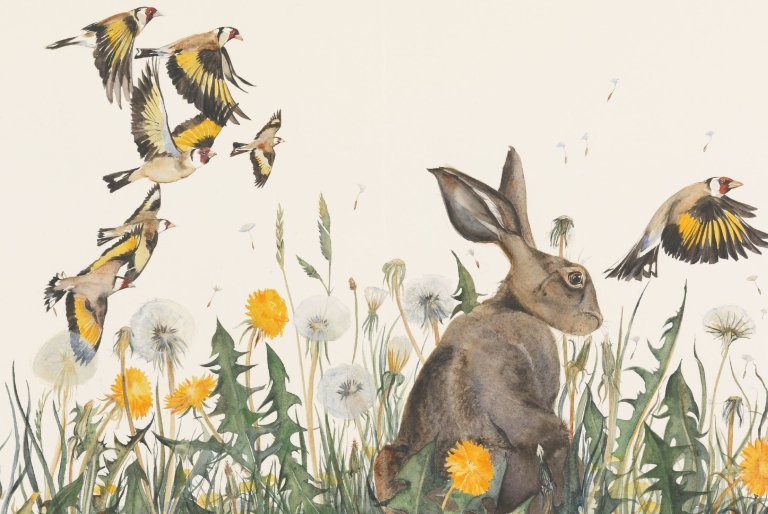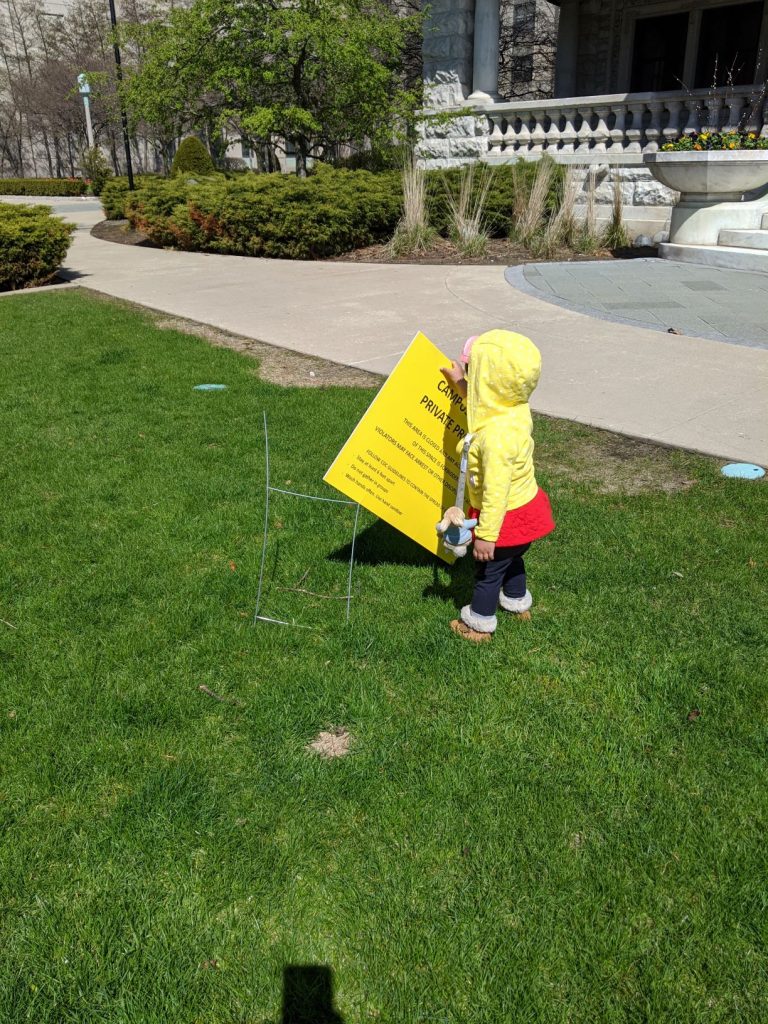“may my heart always be open to little birds/ who are the secret of living”
-E.E. Cummings

In late March 2020, the university sent students home, and, shortly after, the state of Illinois shut down almost everything, including the parks. When that happened, Loyola’s Lake Shore Campus became a haven for suddenly “stay(-and-work-and-caretake)-at-home” parents, athletes needing a place to run and train, and seniors going for their daily constitutional. It became, in essence, a public park, at a time when we didn’t have any others.
Oh, not officially of course. The university put up yellow signs declaring the campus closed and use of the space “forbidden,” while simultaneously, and helpfully, offering reminders on how to social distance if you did happen to be there. Over time, most of the signs were knocked over by the winds, or, in one case, by my daughter, Laila.
Laila and I were among the daily visitors to campus. At the time of the shutdown, she was a year and a half old. She had only recently begun walking, and her vocabulary was limited to such essentials as “book,” “sock,” and “Pat-Pat” (her word for dog). One of her favorite words at the time was “bird,” used primarily in the interrogative, like so much toddler speech, and counting in her estimation as an entire conversation. “Bird?” she would ask, pointing at a Beatrix Potter illustration of a goose in a bonnet; and then on the next page, for the same goose, “Bird?” “Bird? Bird!” she’d inquire of the starlings chattering on the rooftop next door. When the pandemic inevitably shattered our no-screens policy, the first television program I put on for her was a Youtube channel called “CatTV” which consisted entirely of bird-cam footage. “Bird?” she asked, pointing to the television. Yes. Bird.
And so when we began our twice-daily excursions to Loyola’s campus, its bird life was a natural point of interest. Not previously a bird-watcher myself, I decided to learn some names and distinguishing markers to help me relate to her new obsession. It was spring after all, and the robins were hopping about the field abutting Kenmore’s pedestrian promenade. This block was the perfect car-free place for my daughter’s unsteady feet. She spent hours exploring the promenade, sometimes playing, sometimes bursting into tantrums, while rosy northern cardinals sang overhead. Her favorite spot was right in front of Ignatius House, where she watched mourning doves resting on the grass and rabbits grazing in patchwork sunlight. A flurry of sparrows chirped and fluttered around the bird feeder hanging from a tree. (“The birds are having a time,” I recorded in a journal on March 27, 2020.) Laila looked on in delight, wandering in and out of this animal scene.
When kept indoors by rain we spent a lot of time with the oversized book, The Lost Words: A Spell Book by Robert Macfarlane and Jackie Morris. The book was created in response to the Oxford Children’s Dictionary removing from its 2015 edition fifty words related to the natural world: “acorn, adder, bluebell, bramble, conker—gone! Fern, heather, kingfisher, otter, raven, willow, wren…all of them gone!” In this “spellbook for conjuring back these lost words,” each word is honored with poem and painting. Macfarlane’s verse is tactile, alliterative, and dynamic, creating sensory experience through the “Tar-bright oil-slick sheen and/ gloss of starling wing” and the “late day light in a bluebell wood.” Morris offers lush, sensitive illustrations—the long arc of an otter underwater, the inky feathers of a magpie tail. Though the specificity of these nearly-lost words escaped my daughter (remember, we were still just talking “bird”), the chance to spot an owl, berry, or rabbit in its colorful pages kept her fascinated. Morris said in an interview that she hopes the book “is a harbour for those who can no longer get outside,” and indeed it was a critical resource for us in pandemic seclusion. She also said “I hope it will lead a child who has never before noticed the bright song of a little brown bird stop for a moment and listen to its whirr and churr.” I must admit it was me, the adult, who needed this invitation, and it was my child who offered it. With feet that move ever-so-slowly and eyes for what is tiny and close to the earth, she was already attuned to the scrabble of small critters and the “whirr and churr” of “little brown birds.” I was learning to follow along.

Such small birds weren’t the only residents of campus. We regularly saw ducks pecking about in the mud or paddling near the rocks. And then the geese arrived, in mass. One day, a pair of geese were hanging out on the grass near the chapel, and Laila strode right up to them with a cheerful “hiiii.” All the walkers and joggers on campus had also paused to see the geese—the only form of group spectacle remaining to us in the pandemic. Perhaps all our capacities for attention had changed. The geese on the grass was an event worth watching.
You may have noticed signs the university has provided, explaining the ecosystem being encouraged here. Our campus is decidedly urban and, at the same time, on the largest lake in this country, itself a critical migratory path. I had read these signs before, but I hadn’t attended to this ecosystem or figured myself as part of it until now. As spring advanced into May, we watched migrations in real time, the black dotted lines of hundreds or thousands of birds skimming the surface of the lake as they headed north, one v-formation following another, for miles.

Let me not forget the rabbits. Rabbits thrive on the Lake Shore Campus. Laila, who was accompanied on these excursions by a small stuffed Peter Rabbit pinned to her jacket, called them “munno.” These bunnies were stalked and chased by both my toddler and my dog, and for that I apologize to their entire leporidae community. We learned that the rabbits slept in the morning and were most active toward dusk. We learned their favorite spots on campus, and we peered under hedges to ask “Where’d’t go?” These sure-footed creatures always slipped away.
Laila’s burgeoning vocabulary was shaped by her time on campus. Every body of water she saw in a book was a “lake.” Music was and still is “gong gong,” thanks to the bells that ring evenly over the neighborhood. At first the bells alarmed Laila, but eventually they became an opportunity for a dance break. That too is an example of how, during this time, she grew braver and more curious, adventuring through this environment. Physical skills were shaped here too: developing her balance and tread, she walked the wee parapets in the grass along the lake and spent hours trotting up and down the stone steps that lead secretly through the bushes by Piper Hall. This was one of many spots I wouldn’t have visited without her as my guide through the space.
Eventually it was October. The new academic term rolled on, virtually; Laila started preschool. But the pandemic was still with us. So, too, were the animals. The geese were calling to each other in the skies to plan their next journey; the squirrels were scrambling about preparing their hoards for winter. And then, one afternoon, walking home from school, we saw it—a fox! We had seen the fox on those signs about the lakefront ecosystem, but never really believed they were here. And yet. With its full flaming tail pointed up, the fox pounced! Like us, it was hunting rabbits in front of the Norville Center, alongside its cousins the (statues of) wolves. While Laila and “Pat-Pat” were bold enough to try to follow the fox into the brush, I insisted we watch from a distance. The fox met my gaze directly as if to say, “wise choice.”

These days, nearly one year into the pandemic, things are different. Laila speaks in full sentences, and asks “why” questions. She runs, jumps and does yoga. I stopped recording all the new words in her vocabulary, because there are too many of them. She calls our dog by her actual name, Maggie; “Pat-Pat” is now one of the many “lost words,” lost to growing up. She learned the word “campus” last week and immediately started calling Loyola “my campus” (she’s also entered the possessive toddler phase).
These days, it’s the dead of winter. Campus is quiet and still, no animals making themselves known, though we’ve continued to look for them. Though some students seem to be back in residence halls, we rarely see them. After days of snowfall, everything is hushed. “Where’s the lake?” Laila asked the other day as we looked out on the expanse of shelf ice and snow where Lake Michigan used to be, the water stilled to silence below.
Laila plucked an icicle from a hedge and watched in alarm as it melted in her mittened hand. “Why?” We talked then, less about physics and more about change and the passing of time. The snow will melt, I told her, not as quickly as this icicle but just as surely. The birds will come back. As for when human life will return to campus, I can’t say. But it will, once again, be spring.
Works Cited
Macfarlane, Robert and Jackie Morris. The Lost Words: A Spell Book. Anansi Press, 2018.
“Illustrator Jackie Morris Interview.” TOAST Magazine,12 Feb 2018, https://www.toa.st/magazine/interview-illustrator-jackie-morris.htm.
